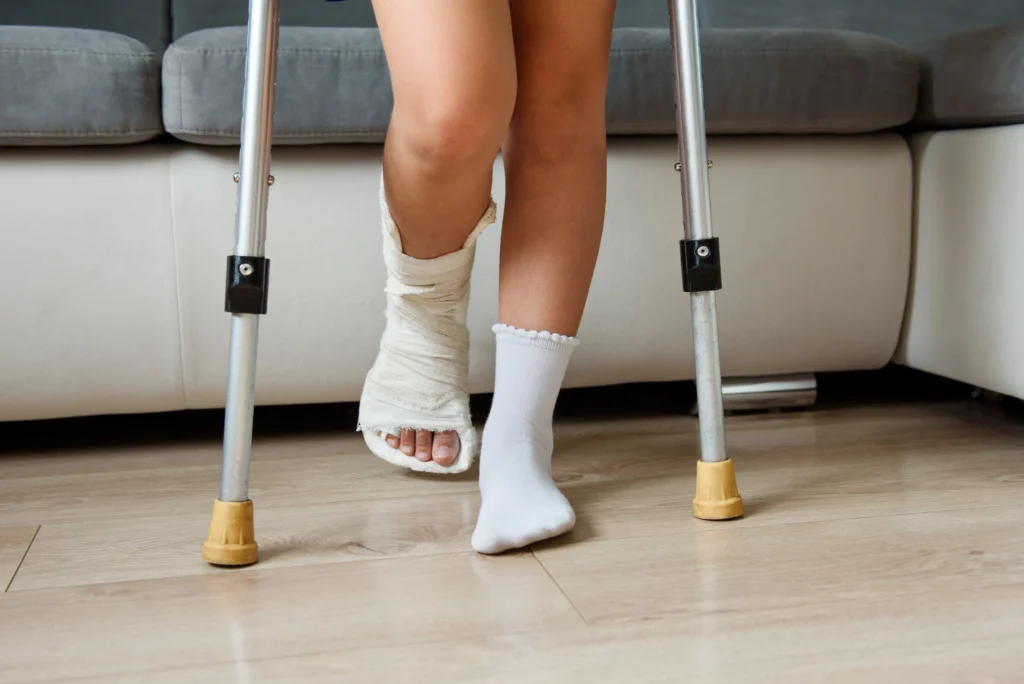Toe and forefoot (bones leading up to the toes) fractures often result from trauma or direct injury to the bone. Fractures can also develop after repetitive activity, such as running during sports and other activities, and they’re common in adolescent winter athletes.
What Is A Fracture?
Fractures can be “non-displaced,” where the bone is cracked but in the correct position, or “displaced,” where the ends of the broken bones are separated. Fractures can also be divided into “closed fractures” where the skin is not broken and “open fractures” where the skin is broken, and the wound extends down to the bone. Open fractures are particularly serious because, once the skin is broken, bacteria can enter the wound and cause infection in the bone. Immediate treatment is required to prevent infection.
The Fifth Metatarsal
The fifth metatarsal is the long bone on the outside of your foot leading up to the small toe. Injuries to this bone may be different than fractures of the first four metatarsals. Avulsion fractures of the fifth metatarsal fracture most commonly at the base of the bone, closest to your ankle. This usually occurs from a “rolled ankle” injury where the foot and ankle are twisted downward and inward and is common in adolescent winter athletes, such as basketball players.
In this type of injury, the tendon that attaches to the base of the fifth metatarsal may stretch and pull a fragment of bone away from the base, causing an “avulsion fracture.” These rarely cause the need for surgery unless they are significantly displaced. Most fifth metatarsal fractures can be treated with full weight bearing in a walking boot.
Jones Fractures
A Jones Fracture is a horizontal fracture at the junction of the base and shaft of the bone. Since the blood supply to this area is poor, these fractures are more prone to difficulties in healing and more commonly require surgery.
Identifying A Fracture
Symptoms of a fracture include pain, particularly walking and weight bearing as well as swelling, bruising, or discoloration. Fractures can also cause loss of sensation which can be an indication of a nerve injury.
Treating A Fracture
Treatment for a toe or forefoot fracture depends upon the location of the injury and the extent of the fracture. Most toe fractures can be treated non-surgically. “Buddy taping” your broken toe to an adjacent toe can provide support and splinting and sometimes help relieve pain. If the bone is out of place and your toe appears deformed, it may be necessary for your doctor to manipulate the fracture to put it back in place. This procedure is most often done in the doctor’s office. You may be given a local anesthetic to numb your foot, then your doctor will manipulate the fracture back into place and straighten your toe.
Alleviating Pain If You Suspect A Fracture
If you think you have a fracture, it is important to see your doctor as soon as possible. While you are waiting to see your doctor, you should begin some basic treatments. You should apply ice and elevate your foot as much as possible to help reduce swelling. You want to limit weight bearing. The foot can be lightly wrapped in a soft compressive dressing.
Imaging For Fractures
Your doctor will order X-rays to evaluate the bone and rule out a fracture. A hairline fracture or a stress fracture, however, may not be visible on a first x-ray.
Immobilizing A Fracture
Like toe fractures, metatarsal fractures can result from either a direct blow to the forefoot or from a twisting injury, common in winter sports such as basketball or hockey. Most metatarsal fractures can be treated non-surgically with an initial period of immobilization and limited weight bearing in a fracture boot or cast.
Healing A Fracture
Toe and forefoot fractures can take up to 8 weeks to completely heal. Your doctor will take several X-rays to ensure proper bony healing and alignment. Even with proper healing, swelling in the foot and toes can be present for 6 months to 1 year following the injury. This may make it difficult to fit in regular shoe gear. Your doctor will instruct you when it is safe to resume activities and sports. If you experience any pain, however, you should stop your activity and notify your doctor. Returning to activities too soon can put you at risk for re-injury.
When To See The Pediatric Orthopedic Center
The Pediatric Orthopedic Center is the premier NJ hub for pediatric orthopedics, with three offices throughout northern NJ and two pediatric-trained foot and ankle specialists. Having been the leader in pediatric orthopedics in this area for 30 years, we are the largest and most award-winning pediatric orthopedic practice in the tri-state area.




